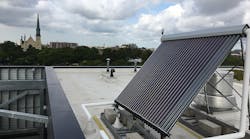Latest from Eatherton
Sponsored
The Solar Decathlon is an opportunity to demonstrate the power and efficiency of hydronics.
The Department of Energy sponsors a biennial contest to help promote energy efficiency and solar utilization in a contest for university students called The Solar Decathlon. This year, the contest was held in Denver, Colorado, and was held in conjunction with the American Solar Energy Society’s annual meetings. Participation is on a strictly voluntary basis. It provides the universities with an opportunity to take their architectural and engineering student development teams to new, unexplored levels of competition.
I had the opportunity to view some of the homes that were on display, thanks to the efforts of Fred Werth. Fred volunteered his time and expertise to help the students develop a grey water recycling system that is used to grow food within the University of Maryland’s house. Thank you, Fred, for the invitation and opportunity to review these projects. By the way, kudos to the Maryland team, which came in a close second to the first-place Swiss team, which had an unlimited budget from which to work. Most schools seek donations from manufacturers to get their projects completed, using student labor to design and install these amazing systems.
In reviewing the contestant homes, of which there were seven homes that made it into this year’s final competition, I noted that many of these experimental homes were being conditioned with VRF and mini split technologies. There was an obvious difference in overall comfort, which we, as practiced radiant comfort people, know and understand. While I am not a big fan of these technologies in general, due to potential refrigerant leaks and the lasting environmental impacts that they would have, I do see a potential in utilizing refrigerant-based technology interface with existing hydronic technology. Simply stated, I believe there is a future for hydronic distribution systems that will use “packaged” factory sealed units that can place the heat (pick a source) directly in to a hydronic radiant comfort package.
These contests make an excellent point of highlighting the material donors, as well as recognizing the expertise that was lent to the students in helping them to achieve the utmost in energy efficiency and comfort.
Some of my readers might remember when I first got involved with the University of Colorado Solar Decathlon team in 2005, and the fact that they won first place two times in a row (2003 and 2005). I introduced them to a technology that we’d been using for quite some time, called WarmBoard. The gracious folks at WarmBoard donated the material, and provided technical advice on its installation and operation. WarmBoard also participated in this year’s competition providing product for the University of California at Davis and University of Nevada Las Vegas projects. Other recognized hydronic equipment manufacturers who participated in the 2017 program were Uponor, Taco, Zehnder and WILO. These projects are all rated based on numerous variables by a panel of judges who are experts in their respective fields.
In addition to these two projects, Washington University at St. Louis incorporated a hydronic radiant system into their comfort/efficiency package. Their comfort package included radiant floor and ceiling heating and cooling systems. This was attempted many years ago (radiant cooling) by one of the participating universities, and they quickly discovered something called the “dew point” and had a rain forest inside their building when they loaded it up with people. This is one of those areas where the volunteer experts from our industry could have saved them from that sort of embarrassment. This is where our industry needs to get involved with these participating organizations and show them something that we’ve known for a very long time, that being that the most efficient method of moving energy from point A to point B, C, D or E is and has always been hydronics.
These contests make an excellent point of highlighting the material donors, as well as recognizing the expertise that was lent to the students in helping them to achieve the utmost in energy efficiency and comfort. Unfortunately, this program doesn’t have the ability to rate these buildings for their inherent “comfort”. Not yet anyway. I want to get involved and have the Department of Energy add an additional sub-category of radiant comfort to their health and comfort grading category. That is something that can be felt by the judges, albeit somewhat subjective grading.
There are new software tools available that can predict and quantify the radiant comfort experience, and I’d like to see these parameters incorporated into the schedules that are used to judge these projects. Having the most energy efficient building in the world is meaningless if the occupants inside are not comfortable. They will just turn the thermostat up until they are comfortable, especially with the air-based systems. As industry icon Robert Bean has been saying for years now, if we design our buildings for occupant comfort, energy efficiency will follow. Let’s show them how to properly control radiant comfort.
The bottom line of this article is that now is the time to get involved. The next contest will be in 2019, again it is being held in Denver, Colorado, about five miles away from the Denver International Airport. This allows plenty of time for our hydronic/radiant industry to become more involved in the design process, and to allow us to bring the engineering students up to speed on the state-of-the-art radiant comfort systems we have to offer, regardless of the energy source. If you or your company are interested in participating as a material donor, or expertise donor/volunteer, I’d strongly recommend that you go to the Department of Energy website of [email protected] and register to receive information on the 2019 contest. Once the list of potential participant schools is out, you should be able to reach out to them and offer your material and expertise.
I’d also strongly recommend that we, as an industry, become more involved in programs like this so that we can tell the world what we’ve all know for a very long time, that being that the use of hydronics for heating and cooling and energy movement in general is the most efficient method known to mankind.
Make a difference. Get involved.
Tune in next month as we re-visit the labor shortfall our industry is currently dealing with. Until then, Happy Holiday hydronicing!
Mark Eatherton material, in print and online, is protected by Copyright 2017. Any reuse of this material (print or electronic) must first have the express written permission of Mark Eatherton and CONTRACTOR magazine. Please contact via email at [email protected]/
Mark Eatherton
Mark Eatherton material on this website is protected by Copyright 2017. Any reuse of this material (print or electronic) must first have the expressed written permission of Mark Eatherton and CONTRACTOR Magazine.


